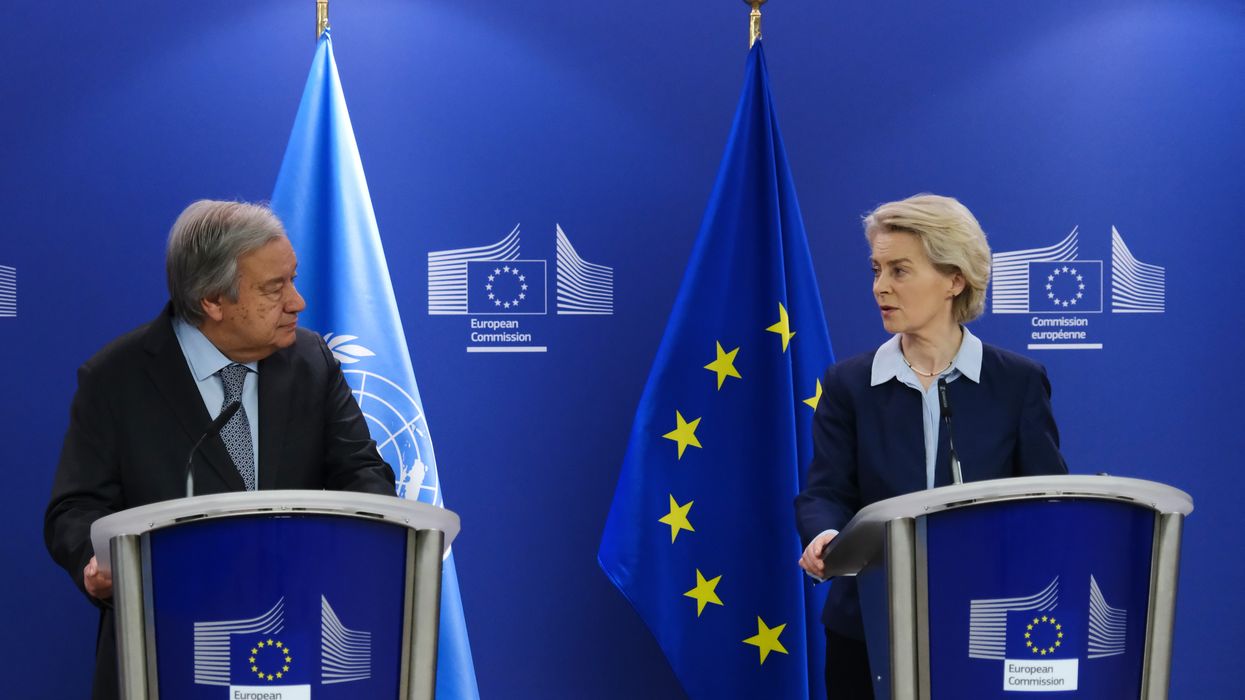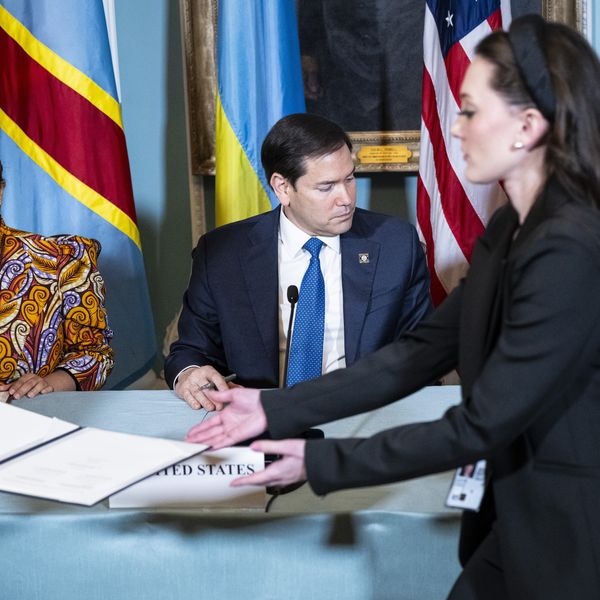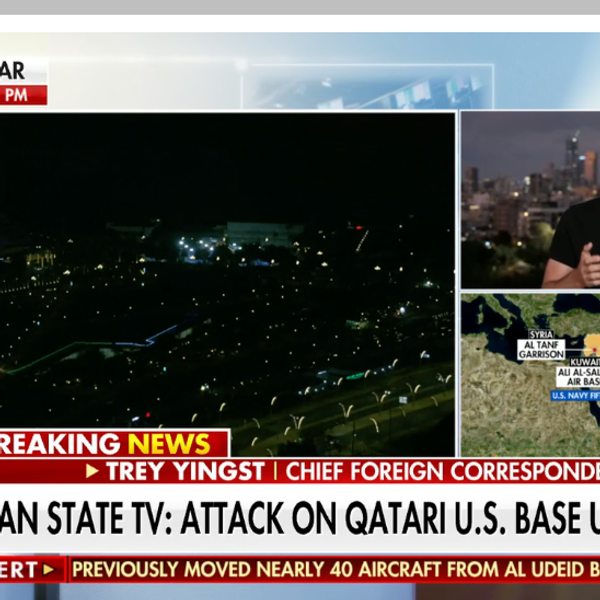As Congress starts its last scheduled workweek of 2023, observers are becoming increasingly concerned that U.S. aid for Ukraine will at least temporarily run out.
The reality of the situation is starting to set in both in Washington and Kyiv. The Biden administration announced recently that aid will run out before the end of the year, and Joe Biden himself argued last week that a cutoff in funding could lead to a direct Russia-NATO conflict.
These stark warnings led Ukrainian President Volodymyr Zelensky to make a surprise visit to the United States this week for emergency meetings with the White House and congressional leadership. It remains unclear whether his pitch will prove convincing to Speaker Mike Johnson (R-La.), who now poses the largest obstacle to continued aid.
So what actually happens if U.S. support for Ukraine dries up? While Kyiv could likely weather a short gap in funding, a longer delay or even permanent cutoff would force the Ukrainians to substantially cut back their military operations, raising the possibility that Russia could reverse Ukraine’s hard-won gains in the country’s east.
The sudden move would also make it substantially harder to reach a negotiated solution in the short term, according to George Beebe of the Quincy Institute.
“[T]hose tempted to believe that the United States could end the war by simply ending its aid to Ukraine should think hard” about how such a move would affect Kyiv’s leverage in talks, Beebe argued in RS.
“The United States should not remove cards from its hand by ending aid to Ukraine unilaterally or playing them prematurely,” he wrote. “But unless it moves quickly to complement aid with diplomacy, it may find that the opportunity to play its cards has suddenly disappeared.”
Playing the numbers game
One important factor complicating discussions about future aid is the widespread uncertainty about exactly how much cash the U.S. still has left to burn. Sen. Mark Warner (D-Va.) said in October that even Congress has struggled at times to get a straight answer on a deadline for new funding.
As of last month, the White House said it had spent roughly 96% of the more than $100 billion Congress has allocated for Ukraine. A Pentagon accounting error left the Department of Defense with several billion dollars of extra “presidential drawdown authority,” which allows the Biden administration to send equipment from U.S. stockpiles. But there is only about $1 billion in funding left to replace those weapons, and the White House has so far been reluctant to send arms without promises to replace them, according to Mark Cancian of the Washington-based Center for Strategic and International Studies.
The impact of a cutoff in funding would not be immediately apparent, especially given the slow pace of fighting during the winter, but would lead to a progressive reduction in Ukrainian operations, Cancian told RS. In his estimation, the pace of aid is “already declining” when compared with the early days of the war, though a steady stream of weapons deliveries will continue for years given the timeline needed to produce new arms.
“As that flow declines, then Ukraine’s military capability will decline with it,” Cancian said. “At some point, probably in January, they would be unable to launch a full-scale counteroffensive, and then maybe in February they'd be unable to do any attacks at all.”
“Maybe later in the spring, Ukraine would be hard-pressed to hold the Russians off,” he continued. “It's not that they won't have any [weapons], but they won't have the flow that's needed to maintain operations at a high level.”
Biden’s supplemental request would allocate about $59 billion in funds related to Ukraine. One third of that goes to humanitarian aid and direct economic support, while the majority goes to various military funding needs.
Of the $38.7 billion in military aid, roughly $30 billion is earmarked for purchasing weapons to send Ukraine or drawing down U.S. stockpiles. The remaining $8 billion would support the expanded U.S. troop presence in Europe in response to the Ukraine war, with a small portion of funds going to aid oversight.
Cancian noted that much of this funding should be understood as an investment in the U.S. economy given how much of it will be directed to American contractors. This argument, which the Biden administration has also made, has drawn criticism from opponents of increased military spending, who note that defense dollars produce fewer jobs than many other forms of government spending.
On the economic front, a sudden cutoff in U.S. funding would be less drastic than an end to military spending given that much of Ukraine’s budgetary aid comes from the European Union. Though even that funding could be blocked by Hungary, which, under right-wing Prime Minister Viktor Orban, has often frustrated its European partners. (Zelensky and Orban appeared to get into a heated argument on the sidelines of the presidential inauguration in Argentina this past weekend.)
Political reverberations
An end to U.S. aid would be a sharp rebuke of the Biden administration, which has long argued that American support for Ukraine will last as long as it takes for Kyiv to achieve its stated aim of retaking all of its territory, including Crimea.
Many believe that European states would also pull back their funding if American support ends, according to Cancian. “The logic is the same as in the U.S.,” he explained. “They have elements that are opposing, on both the left and the right, the high costs and the lack of success. If the United States stops, then many of their critics will point to this and say, ‘The United States is stopping. Why are we sending money for a failing effort?’”
As the possibility of an aid cutoff grows, some analysts have argued that it’s time for the Biden administration to shift its approach to the war and set more realistic objectives — a move that could tamp down concerns in Europe while also responding to the White House’s domestic critics, who argue that the president has no clear strategy for the war.
“[T]he White House should seek to build a new narrative: that this is a war of defence for Ukraine, and a strategic defeat for Russia, and that the US can support Ukraine while also acknowledging that there are other national security priorities that might need to take precedence,” Emma Ashford of the Stimson Center argued in The Guardian. “This narrative is less aspirational, but more pragmatic.”
“[M]ost importantly, if the Biden administration is re-elected in November, this approach would place them in a much stronger position to pursue armistice negotiations in late 2024,” Ashford wrote.
- Most Americans don't want Congress to approve more aid for Ukraine war ›
- Will Ukraine's effort go bankrupt gradually...then suddenly? ›
- EU manages a muddled message of support for Ukraine - Responsible Statecraft ›
- Rightward, populist drift in EU elections signals big Ukraine shift | Responsible Statecraft ›
- NATO chief in DC trying to get blood from a stone | Responsible Statecraft ›
- Diplomacy Watch: Western aid for Ukraine on divergent paths? | Responsible Statecraft ›
- Pass Ukraine aid, but make it conditional on ending the war | Responsible Statecraft ›
- What will more aid to Ukraine accomplish? | Responsible Statecraft ›














